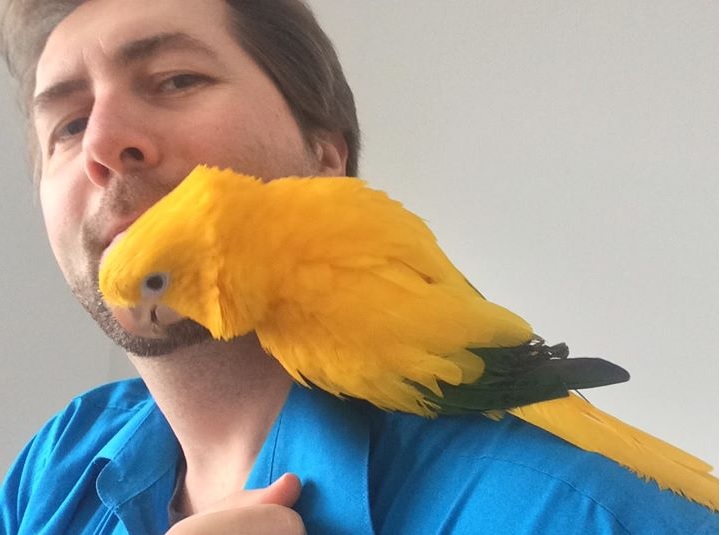ABOUT GOLDEN CONURES | home | ABOUT GOLDEN CONURES | INFORMATION | ABOUT GOLDEN CONURES | Favorite Links | Contact Us Roster FOR CBW REGISTRATIONS FOR THE GOLDEN CONURE DEDICATED AVIANITARIAN
Golden Conures are hardy birds and they appear to be as resistant to disease as other conures. They are, ofcourse, susceptible to the viruses and infectious diseases as any other parrot. Golden Conures do not suffer from any species-specific Disease.. The captive U.S. population of Goldens
 has been relatively free of disease prohlems.
It has been reported that Golden Conure Babies require constant handfeeding to avoid stunting, a condition of underdevelopment usually associated with malnourishment. I have not found this to my experience or addressed in my research reports among my captive bred babies.. In the absence of an infection, Golden Conure babies develop rapidly and require no more attention than those of any other parrot species. I think that the poor immune response of some Golden babies is responsible for these reports of stunted growth due to emplying crops. . My experience in rearing Golden Conures has not been exclusively with artificially incubated eggs. Although productivity is enhanced by artificially incubation, the babies do not receive the advantage of antigens from the crop milk of the hen when left with the parnts. A few of these babies are weakened by
bacterial infections during the first week, even these will thrive with no noticeahle loss in development once the initial prohlem is resolved. In all cases of slow growth, I have found the babies to respond to immune builder envinment for their parents with the Tababua Tree perches used for perches and babboo, bottle brush with the amazing Sea Grapes for diet, perches and esthetic hedges for their privacy. Cultures and sensitivity tests are invaluable in diagnosis of bacterial problems in all parrot species. I am aware of very few losses of adult Goldens due to disease of my 10 founding unrelated individuals in my Aviary, five breeding pair of whch are unrelated to the to earh among the ten.
Longevity appears to be on cue with other parrots. The Golden Conure International Studbook lists wild-caught individuals that lived approximately 40 years in captivity (Lieberman, 1999). Although available statistics are limited, Goldens exhibit every indication of sharing the typical conure hardiness, and can be expected to have longivity.
Conures are descended from a small number of the original wild-caught birds that make up the founder stock. The fIrst difficulty encountered in breeding
Goldens, then, is to secure breeding stock that is not the result of inbreeding. The next difficulty is to avoid inbreeding in your own stock. Analysis of the Golden Conure Studbook indicates that Goldens do not breed as readily as some more commonly kept birds. In my experience, however, they have no unusual breeding
requirements, and can be quite prolific. Many pairs will produce three clutches in a year (or more if eggs are pulled for incubation). I have found them to be dependable breeders, an observation that is supported by Studbook records. Breeding pairs will usually produce every year. Of our six original pairs, three have produced each year after the first success and the other three have produced infertile eggs, with breeding attempts each year. All produce multiple clutches.
The normal clutch size is three to six eggs. Goldens are indeterminate layers, in that they will continue to lay eggs in an attempt to complete a clutch if eggs
are pulled for incubation. As many as 10 to 12 eggs may be laid, but I have found with some pairs all are fertile eggs, indicating that copulation ceases
as egg laying hegins. Golden Conures have proven to be seasonal breeders when housed outdoors in colder climates (Hayward, 1982). Indoors, however,
they will breed at any time during the year. Most of our breeders were of uncertain age when we acquired them.
Reports of Golden Conures breeding under two years of age. Fecundity records in the Studbook indicate reproduction from two through and over 60 Goldens reared to independence, only one has died. On necropsy, that bird was found to have suffered an internal injury. Longevity appears to be on a par with other parrot species. The Golden Conure International Studbook lists wild-caught individuals that lived approximately 40 years in captivity (Lieberman, 1993). Although available statistics are very limited, Goldens exhibit every indication of sharing the typical conure hardiness, and can be expected to have longivity in the cative breding programs.
Tbe Golden Conure is a CITES 1 and a ESA (U.S. endangered species) bird. It is often referred to as the Queen of Bavaria Conure.
|